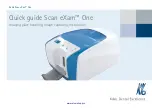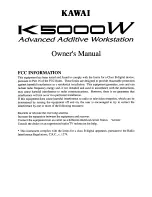
Volume: Modular Synthesis Plug-in System PLG150-AN
y
Power User
PLG150-AN Analog Physical Model
The
PLG150-AN
is a single part plug-in
module. It has 256 preset voices and RAM for
128 user board voices. There are 2 preset banks
of 128 each plus a user bank for your own
custom board voices. The 128 user board voices
are created and/or loaded in with the provided
computer Voice Editor software and exist in a
volatile RAM bank on the board. Think of the
board as a separate synthesizer (in this case like
a little AN1x). When you place the board in the
mothership you can address it from the front
panel and/or the Voice Editor software. The
board is a complete synth. You can load in
custom Voice sets, you can make variations from
the preset data and with the software, you can
create your own analog synth sounds from
scratch. The PLG150-AN will add its own 5-notes
of polyphony to the modular system. It is a
‘physical model’ that will let you route and
control signal just like on an analog synthesizer.
The virtual front panel of the software will let you
get your hands on the sound. You can even
create and assign four special clockable
envelopes, called
Free EGs,
to control any four
parameters in real time. You can assign
parameters to your controller’s knobs and
wheels. The PLG150-AN board has its own clock
which can be assigned to do one of two
functions: an arpeggiator or an old style analog
step sequencer for creating and sync-ing
patterns. It is a
virtual
analog synthesizer, right
down to the phat sounds and physically modeled
filters.
Checking Installation
Check to make sure your board or boards are
properly installed. Here’s how:
On the host: Press [UTILITY]
Use the MENU feature (SHIFT+PAGE) or PAGE
knob to navigate to the PLG Status screen:
v
PLG Status> PLG1:PLG150-
AN
Expand
Plugin PLG2:PLG150-PF
4
----
Figure 1: Your screen may differ according to what
boards you have plugged into which slots. The
“Expand” parameter will be active only when you have
2 boards of the
same
type installed and polyphony
expansion is possible. A second PLG150-AN will give
you a maximum of 10 notes of analog polyphony in
Expand poly mode. Because the System is
modular
,
this polyphony
does not
take away from the 64-note
polyphony of the mothership host (S30 / S80 / CS6x /
CS6R).
Banks of sounds
Load the Plug-in Voices that come with the
PLG150-AN. On the diskette find the appropriate
file: “
anPLG_vc1.mid
” or “
anPLGvce2.mid
”
depending on whether your board is in slot 1 or
slot 2. Playing this file to the S30/80-CS6 synth
will bulk the
Plug-In Voice
data to the 64 PLG
locations associated with the board. You can save
this file to SmartMedia card once you have
loaded it in. PLG series boards can have many
sounds on them (the PLG150-AN has some 256
preset sounds and 128 user locations), 64 can be
integrated with synth and stored in the [PLG]
bank as Plug-in Voices.
Load and play through the PLG bank (Plug-in
Voices). Press [PLG1] or [PLG2] and select sound
A01, the sound called ‘Killer’. There are 64 Plug-
in Voices (A01-D16). If you receive the TYPE
MISMATCH error message you have played the
wrong numbered file for this PLG. A type
mismatch means the Voice data did not find the
appropriate board in the slot. The PLG150-AN
must be in the unit to be addressed by the
voicing parameters.
What is a Plug-in Voice and what is a
Board Voice?
The
Plug-in Voices
are found from the front
panel of the host S/CS synth under the [PLG1]
and [PLG2] buttons, when you have a PLG board
properly installed. The host can store 64 Plug-in
Voices per board (A01-D16). The PLG150-AN
comes with a disk file that will load 64 Plug-In
Voices to your synth. They use the mothership’s
parameters, routing and effects but call on synth
data resident on the board, called the
Board
Voices
. Instead of using ROM samples from the
host, the PLG Voices point to data that is resident
on the PLG board. The Voice data contained on
the PLG150-AN is not based on sampled data like
the internal voices. The sounds of the AN board
PLG150-AN TUTORIAL























